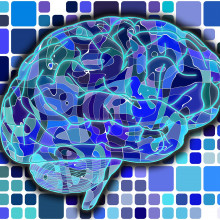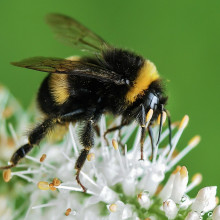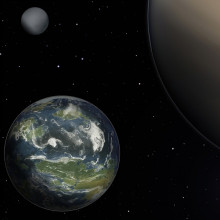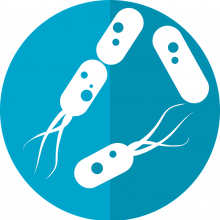Ketamine's antidepressant effect, and bee brains find a way
In the news podcast, could Chinese scientists have found the mechanism that gives ketamine its antidepressant effect? Also, how a Cambridge researcher has laid the foundations for eliminating a form of blindness in English Shepherd dogs, and how bees find their way about with remarkable efficiency. Plus, the big questions in the search for extraterrestrials...
In this episode

00:55 - How ketamine may alleviate depressive symptoms
How ketamine may alleviate depressive symptoms
David Nutt, Imperial College London
For some of those with severe depression, if traditional antidepressants have proven ineffective, they may have been prescribed the powerful anaesthetic ketamine, which has shown great promise in alleviating depressive symptoms in some people. But the exact reason as to why, and what areas of the brain that ketamine actually influences, has remained something of a mystery. Now however, a study from Zejiang University School of Medicine in China points strongly towards a part of the brain called the lateral habenula, responsible for emotional processing and reward function. If what they say is true, the finding could lead to the introduction of ketamine as a mainstream treatment. I’ve been speaking to David Nutt of Imperial College London, and formerly the UK government’s drug tsar, about the paper’s findings...

07:16 - Gene responsible for a form of blindness in dogs identified
Gene responsible for a form of blindness in dogs identified
John Coombs, Edale Mountain Rescue & Cathryn Mellersh, University of Cambridge
Cambridge scientists have identified the genetic mutation that causes progressive retinal atrophy in English Shepherd dogs, a disease which results in incurable blindness as the rods and cones in the eye slowly degrade. The hope is, by identifying the gene responsible, dog breeders will be able to eradicate the condition in the species. Chris Smith interviewed Cambridge’s Cathryn Mellersh, and first, the person responsible for helping the research team a great deal, John Coombs, who owns an English Shepherd dog called Shola…
John - Mountain rescue search dogs are used to locate missing people and are mainly used in the dark and in woodland where visual methods of search don't work and the dog's nose is able to detect people. Shola was trained to do that. She's that good that we decided to have a litter of pups with her, so when I went back to reintroduce her to work with my mountain rescue team, it became evident that she was struggling in the dark. We went to a canine eye specialist and she was diagnosed with PRA
Chris - And Cathryn, what is PRA and how did you become part of this story?
Cathryn - In PRA, which stands for Progressive Retinal Atrophy, the photoreceptors, which are very specialised cells at the back of the eye and that help translate what we see to help our brain understand that as a visual image, in PRA affected dogs these degenerate. They stop working and over time. That means that the affected dog will sadly usually go completely blind.
Chris - These are the rods and cones that people will probably more colloquially know them as. Does the fact John said it manifests in the dark first, is that relevant here?
Cathryn - So the cones work in light situations and help us see colour and visual acuity. So when a human is reading, for example, they're using their cones. When you are in dim light, we use our rods. So the fact that Shola needed to work in low light situations, that was when it was first noticed that her vision was deteriorating, and that was because rods degenerate first. Then, unfortunately, the cones degenerate as well. Then the dog becomes unable to see in light conditions,
Chris - Do we know why this occurs? And therefore what underpinning cause exists for this?
Cathryn - PRA in different breeds is caused by different mutations in different genes. What we do know is that the protein that this gene codes for plays a very important role in the maintenance or the health of photoreceptors. This mutation basically stops that protein working properly.
Chris - And you genetically tested Shola to show that she was actually manifesting one of these gene changes?
Cathryn - We collected DNA from Shola and we actually found five other English Shepherd dogs that were affected with PRA as well. We collected DNA from all of them. We also collected DNA from about 20 English Shepherds whose eyesight was good and we compared the DNA from the affected dogs with the unaffected dogs. We were able to hone in on this mutation. So the dog has about 2.4 billion letters of DNA and we were able to find this mutation, which is actually the insertion of 224 letters of DNA that that shouldn't really be there. So in terms of the whole genome, it's quite a small mistake, but in this case it has quite profound impact on the way that this particular protein functions.
Chris - Is there anything we can do about the condition? Because having detected that this gene change exists in an animal, can we stop or slow down the disease? Can we reverse it or is it irreversible?
Cathryn - So at the moment, it is irreversible, but there's a lot of work going on in human medicine to try and do what is known as gene therapy or gene augmentation where scientists and doctors inject a correct version of this gene into the retina. And because the gene that Shola's mutation is in is shared with humans, it could in time join the collective research that's being done and have a positive impact on our ability to treat this disease in humans at least. I think it's unlikely that we would ever do gene therapy in dogs. It takes a long time to develop and it's very expensive. The real benefit to dogs from this research is we can now screen the DNA of dogs that are going to be bred with and make sure that we don't breed together two dogs that carry the same mutation.
Chris - And John, how's Shola getting on now? Are you compensating for the fact that her sights poor by doing other things in a different way? More things she can smell, more things that she can feel and sense to enable her to maintain her quality of life?
John - Her quality of life, I think it's really good. Dogs, in any case, live in a world of scent and she's able to remember where the obstacles are that she might bump into and seems to have a very happy and relaxed life.

13:42 - Do bee brains show the path to better navigation systems?
Do bee brains show the path to better navigation systems?
Rickesh Patel, Lund University
Researchers at Lund University in Sweden have discovered that bumblebees have incredible navigational memory. Rickesh Patel and colleagues did it by tracking the walking behaviour of foraging bees. Here’s what he told Chris Smith…
Rickesh - For a long time, people have known that bees are very good at constructing these straight line paths from a food location to home and back to that food location again. And one other thing that people have noticed is that bees are really good at making more complex navigational paths. So for instance, bees have been seen to make a shortcut from one food location to another, even though they've never really travelled that path before. At least that's what is thought to be the case. Also, bees will go to multiple flower patches along one flight and, over time, they're able to make really optimised circuits or direct circuits between these food locations before returning home. So these complex navigational tasks require a bit more than just following a single straight line path back to home. Again, bees can use landmarks to navigate, but it seems that this system gets better over time, which may indicate that perhaps it's these straight line paths that are being used together that might explain how they're able to do these sorts of tasks.
Chris - It sounds from what you're saying like you regard the bees as having a load of memories of places that are connected by a straight line, but they can link up those different memories, different paths from one place to another, to almost create a map in their brains.
Rickesh - I think you can think of it like a web in which there are these nodes, familiar places, and these straight lines that connect these nodes together. This is just an idea. No one actually knows if this is true.
Chris - But what experiments were you able to do that would convince you or has convinced you that this is probably what's going on?
Rickesh - In order to study how bees are able to keep track of these directions and distances in their brains, I needed to be able to construct a situation in which bees were only using vector navigation, these straight line paths, and not using any visual features which bees are also quite good at doing. And since they're travelling over kilometres, I needed to devise a way of making bees navigate in the lab over very short distances. So I used bumblebees and I made them navigate over very small distances about a metre and a half in a symmetrical arena, and I forced them to walk in the arena. I found that, while walking, bees were making these vector paths, these straight line paths to find home and food. Now for this study, I found with a control experiment that surprisingly it seemed that bees were able to remember the straight line paths that they had constructed during previous days of foraging and would use those paths to navigate home.
Chris - And you regard this as a long-term memory because they seem to preserve it over days at a time? They'll resort or relapse back to these same paths showing that they've stored, this is the connection between A and B that I follow. And they keep using that over a period of time?
Rickesh - Exactly, yes. So the working memory that I talked about before, we caused the working memory to give one behavioural readout: the bee, if it was using its working memory will go one direction, but if it's using its long-term memory it would go a different one. We found that we can predict when the bee goes in either of these two predicted directions, which gives support that they are actually using navigational vectors, these directions and distances they need to travel, that's stored in long-term memory. And they can recall this memory when they're at that familiar location in the arena.
Chris - Does the reason they operate like this reflect the fact that they do have quite a small brain? So it's kind of an optimal way of storing a lot of information. You've got these threads connecting position A and position B, position X and position Y, and if you've got all these things stored as simple vectors, it's very easy to store that information in a small number of nerve cells which they've got.
Rickesh - That's exactly right.
Chris - Is there anything we can learn from this about making better navigational tools or systems ourselves if they can do this and do it so well and so efficiently with a very small amount of information being stored? Can we steal that?
Rickesh - That is one of the goals of this avenue of research. So I have collaborators that I'm working with here at Lund who study the detailed neuroanatomy of insect brains in general, and they can identify which neurons communicate with other neurons and we can build a circuit map. And from this anatomical information we can construct models for how vectors might be built in the brain of these insects. So if we can figure this out, and if we have the behavioural evidence to support this, we can then potentially create robots that can do very similar navigational tasks as these insects with a very small circuit. These robots can be useful for situations in which perhaps what we currently rely on, like GPS, do not work. So for example, if you can create an autonomous robot to find people in a disaster zone like an earthquake or a war zone, they could potentially go in a cavern or in rubble, find someone and communicate where they are and find their way back to a rescue team, perhaps. This is just an idea, but there are potential applications in which we can take advantage of what evolution has built in these really tiny animals to do complex tasks really well.

19:11 - Searching for ET in the exoplanet revolution
Searching for ET in the exoplanet revolution
Adam Frank
Are aliens real? Why haven’t we found them? And what happens if we do? Those are a few of the questions that the astrophysicist Adam Frank has set out to answer in his excellent new book: A Brief Guide to Aliens. Chris Smith has been speaking to him…
Adam - I certainly am very optimistic about the possibilities of at least microbial life. I think it's going to be pretty hard to imagine that microbial life hasn't evolved elsewhere in the universe, probably quite often. Now, animals, and then intelligence, that may be difficult for evolution to achieve looking at Earth's own history. But I certainly think that life in general is going to be quite common in the universe.
Chris - The odds do look good, don't they? If we look at the statistical calculations people have done in the past, looking at how many stars there are in the billions and billions of galaxies that we have and so on, it does look odds on that there are going to be other Earth-like entities out there where the conditions we judge to be ideal for the same sorts of coincidences to line up like they did on Earth.
Adam - Well, that is really something that is recent, that statistical understanding, because it comes from what I call the exoplanet revolution. We discovered our first planet orbiting another star only in 1995. Before that, some people thought that planets were very, very rare. Now we understand that every star that you see in the night sky hosts a family of worlds. And if you count up five of those stars, one of them has a planet in the right place for life to form, meaning that liquid water could form. Now, of course, until you look and you find it, statistics is still just a guess. But in terms of at least having places to look, there's been an explosion of possibilities.
Chris - Where in the pecking order of life's evolutionary timeline across the universe would we sit? In terms of, we are in the Milky Way, so how old does that make us and the rate at which life has evolved here and when it got started, versus are there older aliens and younger aliens than us out there somewhere?
Adam - That's a great question. So the universe is about 13 or 14 billion years old. The Milky Way galaxy is 10 billion years old. The Sun and the Earth are around four and a half billion years old. Earth life is somewhere around 3 and a half to 4 billion years old. So what that means is there's absolutely the possibility of younger life, planets that have formed more recently. But it also means that there may be stars and planets that formed when the galaxy formed 10 billion years ago that have had life on them for quite a long time. The interesting thing is, though, that the habitable lifetime of a planet is not infinite, right? That actually on Earth, at some point, the Sun in about a billion years if going to get hot enough that it will boil the oceans away. So, unless we get on spaceships and leave, Earth will become uninhabitable in about a billion years. So there is sort of a finite lifetime for how long a planet can support life.
Chris - The big question about aliens, given the timeline you've given us is, well, where are they? But if space poses such an obstacle, maybe we are all confined to our own cosmic neighbourhoods and we're not ever destined to say hello to ET.
Adam - I think that's a real possibility. I think solar systems can certainly be inhabited. In another thousand years, if we make it through climate change and everything, I could imagine billions of human beings spread throughout the solar system, but travel between the stars, it's maybe something that's very difficult and is not done very much; for economic reasons, for timeline reasons, for lots of different reasons. That may be one answer to what's called the Fermi paradox, which is the, 'Why aren't they here now?' question.
Chris - It was Frank Drake who was one of the people who sent that famous message out into space inviting ET to recognise that humans are here. Not many people expect we're going to hear back from anyone anytime soon, of course, but if we did, do you devote some column inches in the book to how we should have first contact, what should be done, if anything?
Adam - So I do talk about METI: messaging extraterrestrial intelligence. In general, I'm not a big fan of it because really we don't know what's out there. It may be that the best decision is to lay low. Don't stick your head above the grass and be like, 'Hey, we're here, we're tasty.'
Chris - Isn't it a bit late to lay low, though? We've got a hundred years plus of us beaming stuff into outer space and anyone who's eavesdropping, it's there emerging as a bubble radiating away from Earth at the speed of light. It's there, a hundred years away from Earth now, isn't it? So we can't get it back.
Adam - Well, except that that is very low power. Unless somebody knew exactly where to look, they wouldn't hear us. There's all kinds of radio transmissions in the galaxy. The thing about everything that we've pumped out there, it's true that we've been putting out emissions, but it's been like a low hum, a barely audible hum. So there is really, I think, a difference in terms of how noticeable the message would be. When you do METI, you are really screaming into the void.
Chris - Do you think, Adam, before you finish your career and write your last book, that we'll have evidence of extraterrestrial life somewhere?
Adam - I tell you what I'm certain of, I'm certain we will have data relevant to the question, and that's new, right? It may be that we search and we don't find anything, that's already important information because we will have searched through the nearby stars and planets and if we really don't find anything that's already telling us something. For the first time, we are really going to have data that is going to take us beyond just yelling our opinions at each other and that's going to be really exciting. I'm optimistic. I do believe we're going to get some really interesting data from staring at these planets. What exactly it's going tell us, I can't tell you, but I can tell you that it will be groundbreaking either way.











Comments
Add a comment